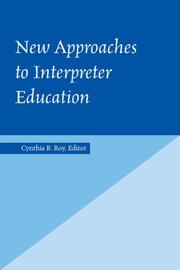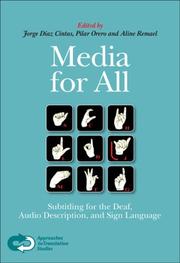| Listing 1 - 3 of 3 |
Sort by
|

ISBN: 1563683814 9781563683817 9781563683800 1563683806 9781563682971 1563682974 9781563683794 1563683792 1563682966 9781563682964 Year: 2006 Publisher: [Place of publication not identified] Gallaudet University Press
Abstract | Keywords | Export | Availability | Bookmark
 Loading...
Loading...Choose an application
- Reference Manager
- EndNote
- RefWorks (Direct export to RefWorks)
Telecommunications devices for the deaf --- Closed captioning --- Deaf --- Disabilities --- Social Welfare & Social Work --- Social Sciences --- TDD (Telecommunications devices for the deaf) --- Teletypewriters for the deaf --- Text telephones (Telecommunications devices for the deaf) --- TTY/TDD (Telecommunications devices for the deaf) --- Communication devices for people with disabilities --- Deaf-mutes --- Deaf people --- Deafness --- Hearing impaired --- Deafblind people --- Captioning, Closed --- Close captioning --- Closed caption television --- Closed caption video recordings --- Television captioning (Closed captioning) --- Video captioning (Closed captioning) --- Translating and interpreting --- History --- Government policy --- Civil rights --- Means of communication --- Patients --- Services for --- Subtitles (Motion pictures, television, etc.) --- Interpreters for the deaf --- Sign language --- #KVHA:Vertaaldidactiek --- #KVHA:Vertaalwetenschap --- Gesture language --- Language and languages --- Gesture --- Signs and symbols --- Deaf, Interpreters for --- Sign language interpreters --- Translators --- Education --- Study and teaching --- Translating services --- Gebarentaal --- Tolken --- Tolken voor doven --- tolken. --- opleiding. --- Multilingualism. --- Sign language. --- Intercultural communication. --- Language. --- Means of communication. --- Study and teaching. --- Telecommunications devices for deaf people --- Deaf people.

ISBN: 9401209561 904202304X 9789042023048 Year: 2007 Publisher: Amsterdam ; New York : Rodopi,
Abstract | Keywords | Export | Availability | Bookmark
 Loading...
Loading...Choose an application
- Reference Manager
- EndNote
- RefWorks (Direct export to RefWorks)
This book, a first in its kind, offers a survey of the present state of affairs in media accessibility research and practice. It focuses on professional practices which are relative newcomers within the field of audiovisual translation and media studies, namely, audio description for the blind and visually impaired, sign language, and subtitling for the deaf and the hard-of-hearing for television, DVD, cinema, internet and live performances. Thanks to the work of lobbying groups and the introduction of legislation in some countries, media accessibility is an area that has recently gained marked visibility in our society. It has begun to appear in university curricula across Europe, and is the topic of numerous specialised conferences. The target readership of this book is first and foremost the growing number of academics involved in audiovisual translation at universities – researchers, teachers and students – but it is also of interest to the ever-expanding pool of practitioners and translators, who may wish to improve their crafts. The collection also addresses media scholars, members of deaf and blind associations, TV channels, and cinema or theatre managements who have embarked on the task of making their programmes and venues accessible to the visually and hearing impaired.
Hearing impaired --- Deaf --- People with visual disabilities --- Audiodescription --- Closed captioning --- Motion pictures --- Television programs --- Audiodescription. --- Closed captioning. --- Titling of television programs --- Motion picture titling --- Titling of motion pictures --- Deaf services --- Captioning, Closed --- Close captioning --- Closed caption television --- Closed caption video recordings --- Television captioning (Closed captioning) --- Video captioning (Closed captioning) --- Translating and interpreting --- Audio-description --- Programs, Television --- Shows, Television --- Television shows --- TV shows --- Television broadcasting --- Electronic program guides (Television) --- Television scripts --- Cinema --- Feature films --- Films --- Movies --- Moving-pictures --- Audio-visual materials --- Mass media --- Performing arts --- Subtitles (Motion pictures, television, etc.) --- Partially seeing persons --- Partially sighted persons --- Vision disorders --- Visually disabled persons --- Visually handicapped --- Visually impaired persons --- People with disabilities --- Deaf-mutes --- Deaf people --- Deafness --- Deafblind people --- Hard-of-hearing --- Hearing disorders --- Partial hearing --- Partially hearing --- Services for --- Titling --- Services for. --- Titling. --- History and criticism --- Patients --- Subtitling of television programs --- Motion picture subtitling --- Subtitling --- Hard of hearing people
Book
ISBN: 9789042031807 9042031808 9789042031814 9042031816 1282916882 9786612916885 Year: 2010 Volume: 33 Publisher: Amsterdam Rodopi
Abstract | Keywords | Export | Availability | Bookmark
 Loading...
Loading...Choose an application
- Reference Manager
- EndNote
- RefWorks (Direct export to RefWorks)
This volume aims to take the pulse of the changes taking place in the thriving field of Audiovisual Translation and to offer new insights into both theoretical and practical issues. Academics and practitioners of proven international reputation are given voice in three distinctive sections pivoting around the main areas of subtitling and dubbing, media accessibility (subtitling for the deaf and hard-of-hearing and audio description), and didactic applications of AVT. Many countries, languages, transfer modes, audiences and genres are considered in order to provide the reader with a wide overview of the current state of the art in the field. This volume will be of interest not only for researchers, teachers and students in linguistics, translation and film studies, but also to translators and language professionals who want to expand their sphere of activity.
Films --- Télévision --- Traduction --- Médias --- Vidéos pour handicapés auditifs --- Aveugles --- Doublage --- Émissions --- Accessibilité aux handicapés --- Et les médias --- Sous-titrage --- Dubbing of motion pictures --- Dubbing of television programs --- Video recordings for the hearing impaired --- Translating and interpreting --- ondertiteling --- Translation science --- Film --- Audio description --- audiodescriptie --- Subtitling. Supertitling --- #KVHA:Vertaalwetenschap --- #KVHA:Audiovisuele vertaling --- Closed caption video recordings --- Deaf, Video recordings for the --- Video captioning (Closed captioning) --- Video recordings for the deaf --- Hearing impaired --- Television programs --- Dubbing of moving-pictures --- Motion pictures --- Dubbing --- Congresses --- Ondertiteling. Boventiteling --- Audiodescriptie --- Accessibilité aux handicapés. --- Sous-titrage. --- Cinéma --- Audio-visual translation --- Vidéos pour handicapés auditifs. --- Et les médias. --- Dubbing of motion pictures. --- Dubbing of television programs. --- Translating and interpreting. --- Video recordings for the hearing impaired. --- Interpretation and translation --- Interpreting and translating --- Language and languages --- Literature --- Translation and interpretation --- Translators --- Translating --- Deaf --- People with visual disabilities --- Audiodescription --- Closed captioning --- Services for --- Titling --- Programs, Television --- Shows, Television --- Television shows --- TV shows --- Television broadcasting --- Electronic program guides (Television) --- Television scripts --- Cinema --- Feature films --- Movies --- Moving-pictures --- Audio-visual materials --- Mass media --- Performing arts --- Captioning, Closed --- Close captioning --- Closed caption television --- Television captioning (Closed captioning) --- Subtitles (Motion pictures, television, etc.) --- Audio-description --- Partially seeing persons --- Partially sighted persons --- Vision disorders --- Visually disabled persons --- Visually handicapped --- Visually impaired persons --- People with disabilities --- Deaf-mutes --- Deaf people --- Deafness --- Deafblind people --- Hard-of-hearing --- Hearing disorders --- Partial hearing --- Partially hearing --- History and criticism --- Patients --- Doublage. --- Émissions. --- Accessibilité aux handicapés. --- Et les médias. --- Émissions télévisées. --- Dubbing of motion pictures - Congresses --- Dubbing of television programs - Congresses --- Video recordings for the hearing impaired - Congresses --- Translating and interpreting - Congresses --- Hard of hearing people --- Hard of hearing
| Listing 1 - 3 of 3 |
Sort by
|

 Search
Search Feedback
Feedback About UniCat
About UniCat  Help
Help News
News